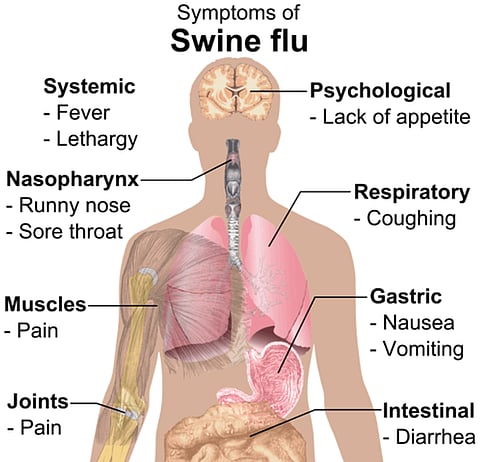
- Home
- न्यूजग्राम
- India
- World
- Politics
- Entertainment
- Culture
- Lifestyle
- Economy
- Sports
- Sp. Coverage
- Misc.
- NewsGram Exclusive
- Jobs / Internships

New Delhi (India), Aug 22, 2017: Swine Flu can get transferred from one person to another. Thus, it creates a panic situation whenever a single person is infected with this disease. To avoid catching this disease we can take some precautions.
As per the data from the Ministry of Health and Family Welfare India- there has been 8,648 Swine Flu cases and 345 deaths caused by this disease till May 7, 2017. There were 1,786 Swine Flu cases and 265 deaths caused by it in 2016. Till May 7, Tamil Nadu alone has had 2,798 cases of it, 181 and 130 people suffered at the hands of this disease in Maharashtra and Gujarat respectively. The worst years for Swine Flu outbreak in India were 2009-10 when it affected almost 50,000 people and took more than 2,700 lives across the country.
According to ANI report, some important guidelines on diagnosis of Swine Flu are given below. We have also mentioned the steps one should take if they catch Swine Flu and other crucial pointers which you don't want to miss.
What is Swine Flu?
Swine flu is a disease that attacks the respiratory tract of pigs, is caused by influenza viruses. The symptoms shown by an infected animal are barking cough, decreased appetite, listless behavior and nasal secretions. The virus can mutate and get easily transmissible in humans.
Also Read: 40 swine flu cases in Delhi already in 2016
Where did it originate from?
The first time when Swine Flu was identified in humans was in the year 2009 in Mexico. After a few months, the very first of the swine flu cases were reported; slowly the rate, at which H1N1-related illness started spreading, was increasing around the globe. As a result, in August 2010 the World Health Organization (WHO) declared the infection 'a global pandemic' (a disease prevalent all over the world).
Even now, H1N1 has not stopped spreading is still getting circulated in humans, as a 'seasonal flu virus' and protection against this strain was thus included in seasonal flu vaccines. More recently, another strain, H3N2 infected humans in 2011.
What is the time period till this disease lasts?
Generally, the incubation period of a swine flu virus is between 3 to 7 days but if one catches a serious infection it can last about 9 or even 10 days.
What are the symptoms?
H1N1 flu symptoms take some time to develop, it takes around 1 to 3 days in humans. This is after they are exposed to the virus.
Some Common symptoms are:
Is Vaccination possible and available?
If you want to reduce the risk of contracting the influenza virus, it can be done through vaccinations. Consult your doctor if you think you are at a higher risk of acquiring this infection. The need to get vaccinated increases if one is traveling to a place where many cases have been recently reported.
The High-risk groups are:
How to get it Diagnosed?
If you want to get it diagnosed, it can be done by taking a nose or throat swab. This should be done within the first 5 days of the illness, this being the most infectious period of the disease. Only a few labs are authorized to conduct Swine Flu tests. The Swab results take 8 to 24 hours, after seeing the results and consulting the doctor, the patient will know if he/she has this disease. Some labs are well equipped with a skilled technician if you prefer a home collection of the sample. "The expert team of pathologists is also able to guide clinicians and patients for report analysis and queries surrounding swine flu diagnosis," mentions ANI report.
Apart from taking vaccines and getting tested for Swine Flu. One of the easiest ways to prevent catching swine flu is by maintaining a basic hygiene routine which includes washing your hands on a regular basis.
NewsGram is a Chicago-based non-profit media organization. We depend upon support from our readers to maintain our objective reporting. Show your support by Donating to NewsGram. Donations to NewsGram are tax-exempt.
Click here- www.newsgram.com/donate
